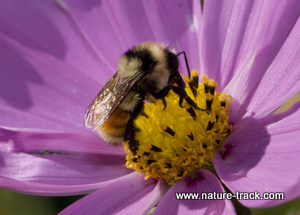Bumble Bees

Bumble bee flight doesn’t defy the laws of aerodynamics but they are still interesting and important native species.
“According to the laws of aerodynamics, bumble bees cannot fly,” stated the motivational speaker emphatically. “Their bodies are too heavy for the wings to lift.” Then he sagely concluded, “But don’t tell that to the bumble bee.” His point was clear: Since bumble bees don’t read physics texts, they do the impossible, so don’t let anyone tell you that you can’t do something.
I wholeheartedly agree with the sentiment, but it is based on an old wives’ tale. Bumble bees don’t defy the laws of aerodynamics. They just exploit a process called non-linear dynamic stall that builds a temporary vortex on top of the wing. As this vortex moves from front to back, it creates up to three times the normal lift. There is no magic, just the physics of wings that move fast and rapidly change angles.
There are about 50 species of native bumble bees in North America. They may be small as a honeybee or as large as a quarter, “furry” and usually are a combination of black with orange, yellow or white.
You may hear a bumble bee before you see it because of its ominous buzzing. This was once thought to be wing movement but the bumble bee can buzz without moving its wings. Buzzing results from the rapid vibration of the wing muscles which can be disconnected from the wings.
Buzzing is useful in several ways. Bumble bees use it to warm their bodies just as ground squirrels waking from hibernation use shivering. Some queen bumble bees buzz to warm their eggs and hasten development.
The buzzing serves another purpose as well. When a bumble bee grabs onto a blossom and buzzes, the vibration can dislodge even the most stubborn pollen from the anthers. Known as sonic or buzz pollination, this is key for pollinating about eight percent of the world’s plants. Tomato growers routinely house colonies of bumble bees in their greenhouses as honeybees are very poor tomato pollinators.
Like the non-native honeybee, bumble bees are social insects. The colony starts when a single queen emerges from her winter hibernation where, like a bear, she has been surviving on fat accumulated the fall before. She immediately seeks a pollen source from an early blooming species such as willow. Then she finds an appropriate home—
an abandoned mouse hole is about perfect—for her new colony.
She lays a few eggs and gathers provisions for them. After these hatch, grow and then pupate, she lays another batch. Once the first group, all sterile worker bees, hatches, the queen will rarely leave the nest, concentrating instead on producing up to 400 offspring.
Near the end of summer, one of the last batches of eggs becomes males and new queens. Queens and males mate, queens head off to find shelter to overwinter and workers and males await their fate.
While it may be a myth that bumblebees defy the laws of aerodynamics, there is still plenty to admire about these cute, essential native bees.

"WOW. What a phenomenal piece you wrote. You are amazing." Jennifer Jackson
That is embarrassing, but actually a fairly typical response to my nature essays. Since The Best of Nature is created from the very best of 16 years of these nature essays published weekly in the Idaho Falls Post Register (online readership 70,000), it is a fine read. It covers a wide variety of topics including humorous glimpses of nature, philosophy, natural history, and conservation. Readers praise the style, breadth of subject matter and my ability to communicate complex and emotional topics in a relaxed and understandable manner.
Everyone can find something to love in this book. From teenagers to octogenarians, from the coffee shop to the school room, these nature essays are widely read and enjoyed.
Some of the essays here are my personal favorites, others seemed to strike a chord with readers. Most have an important message or lesson that will resonate with you. They are written with a goal to simultaneously entertain and educate about the wonderful workings of nature. Some will make you laugh out loud and others will bring a tear to the eye and warm your heart.
Readers Write:
"You hit a home run with your article on, Big Questions in Nature. It should be required reading for everyone who has lost touch with nature...great job!" Joe Chapman
"We enjoyed your column, Bloom Where Planted. Some of the best writing yet. The Post Register is fortunate to have your weekly columns." Lou Griffin.
To read more and to order a copy, click here or get the Kindle version
Copies are also available at:
Post Register
Island Park Builders Supply (upstairs)
Barnes and Noble in Idaho Falls
Harriman State Park, Island Park
Museum of Idaho
Valley Books, Jackson Wyoming
Avocet Corner Bookstore, Bear River National Wildlife Refuge, Brigham City, Utah
Craters of the Moon National Monument Bookstore, Arco, Idaho